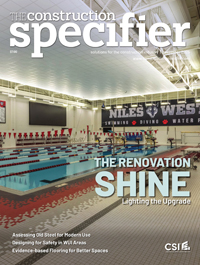Woven wire puts colorful face on children’s hospital

The colorful, attention-grabbing façade for the University of Florida (UF) Health Shands Children’s Hospital is courtesy of a new painted, stainless steel woven wire mesh assembly.
For the past several years, UF Health has been working toward consolidating pediatric services within the Gainesville university medical center. A planned renovation for the east entry atrium and building façade led the owners to realize it was time to establish a completely separate identity for the children’s facility, which is essentially a hospital within a hospital on the UF Health campus.
“The portal project is now rebranding the entrance to the building so our smallest patients do not have to enter through the adult hospital,” said vice-president of facilities development at UF Health Shands Hospital, Bradley S. Pollitt, AIA.
Understanding a hospital can feel ominous to children, the owners asked the architectural firm, Ponikvar and Associates, to take a child-friendly approach to the renovation, while at the same time creating a separate identity to differentiate it from other areas of the facility.
“We were challenged to do something that was child-like without being childish,” explained the firm’s Jack Ponikvar.
This differentiation demanded a dramatic change to the building’s exterior. Months of reviewing design options and product research led architecture and construction management firm, Ajax Building Corporation, to consider a light and colorful alternative to the somberness of the existing brick façade.

Made from architectural grade T316 stainless steel, the specified woven wire mesh provided options unavailable with other materials. The color selection allowed for a bright, multi-color façade layered over the existing brick cladding, which would be appealing to young patients while also establishing a new identity for the building. Additionally, creating colored façades with woven wire mesh presents a multitude of unique design options. The interaction of artificial light, daylight, transparency, luminosity, and color ensures the façade’s stylistic effects change continually. The painted woven wire mesh is durable, weather-resistant, and virtually maintenance-free.
Bringing the visually striking design to life was not without its challenges. Designed to represent rolling hills, the façade’s outermost skin is made up of 26 multi-barrette panels, which are painted green. These include 19 panels, 26 m (85-ft) long that diagonally slope approximately 22.8 m (75 ft) over the span of the design. Supporting the mesh panels at the changing elevations to maintain the rolling hills visual provided a unique test for the installation team. However, overcoming the obstacles has proven worthwhile in the appearance of the finished product.
The manufacturer produced sample panels for review by the owners, architecture firm, and project managers. Using a crane, the sample panels were positioned in front of the existing façade to determine the visual effect that would be created once they were in place.
“Multi-colored stainless steel woven mesh fabric panels are attached to a two-layer structural steel framework that is connected to the façade of the existing 12-story north tower,” explained Ajax’s Thomas G. Crow.
The woven wire mesh is manufactured to specification for each project. The product provides a play of light and shade, gloss, and transparency give each project its own unmistakable identity. Depending on the mesh’s type and size, the surface can be transformed into a stylishly transparent or more opaque visual anti-glare surface. A weave pattern with a 25 percent open area was used for the Shands Children’s Hospital project.
 Wendy DeCapite has been with W.S. Tyler for nearly 15 years. Beginning her career as a customer service representative in the laboratory equipment industry, she was quickly promoted to establish W.S. Tyler’s architectural design wire cloth department. For the past nine years DeCapite has been working to educate and introduce the architectural community to the new material for applications such as parking garage façades, design interior cladding, and creative metal sculptures.
Wendy DeCapite has been with W.S. Tyler for nearly 15 years. Beginning her career as a customer service representative in the laboratory equipment industry, she was quickly promoted to establish W.S. Tyler’s architectural design wire cloth department. For the past nine years DeCapite has been working to educate and introduce the architectural community to the new material for applications such as parking garage façades, design interior cladding, and creative metal sculptures.


